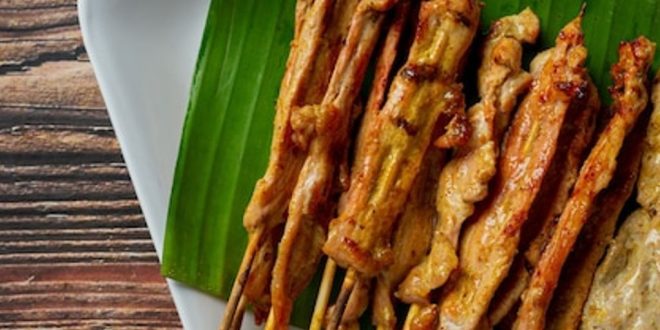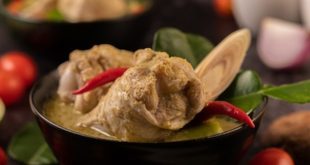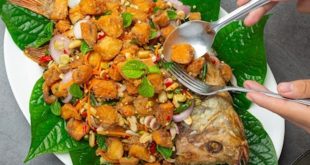Introduction to Traditional Indonesian Street Food
Embark on a flavorsome journey through the bustling streets of Indonesia, where traditional Indonesian street food captures the heart and soul of the nation’s diverse culinary heritage. From the sizzling sounds of satay skewers over an open flame to the tantalizing aroma of freshly fried gorengan, the vibrant street food scene offers an authentic taste of Indonesia that is both exhilarating and satisfying. Understanding traditional Indonesian street food is not just about savoring delicious flavors; it’s about connecting with the rich cultural tapestry that each dish represents.
For those eager to explore authentic Indonesian street food, it’s essential to appreciate its cultural significance and ensure a safe culinary experience. Street food in Indonesia is a reflection of the country’s history, geography, and multicultural influences, making it a vital aspect of Indonesia’s identity. In this article, you’ll discover how to navigate the vibrant food stalls, learn tips to enjoy these culinary delights safely, and appreciate the unique stories behind each bite. By delving into this world of traditional Indonesian street food, you’ll gain insights into the local way of life and enrich your travel experience with unforgettable tastes and memories.
Introduction to Indonesian Street Food
The Cultural Significance of Street Food in Indonesia
Traditional Indonesian street food is more than just a culinary delight; it is a cultural tapestry that weaves through the lives of Indonesians. Street food in Indonesia reflects the country’s rich heritage, diverse cultures, and social fabric. It serves as a communal experience, where locals gather to enjoy affordable meals while engaging in lively conversations. From bustling cities to serene villages, street vendors are integral to daily life, offering a variety of Indonesian snacks and local delicacies that showcase the nation’s culinary traditions.
Indonesian street food is deeply embedded in the country’s history and social structure. The street food culture provides a unique way for people to connect with their heritage, as many recipes have been passed down through generations. It also offers travelers, food enthusiasts, and cultural explorers the opportunity to engage with authentic Indonesian cuisine, experiencing flavors that are both distinctive and representative of the country’s diversity.
The street food scene in Indonesia is not just about food; it is about the stories behind each dish, the origin of ingredients, and the passion of the street vendors who prepare them. Each bite of traditional Indonesian street food tells a tale of regional influences, from the spicy kick of Padang cuisine to the sweet coconut flavors of Javanese dishes. This culinary exploration allows visitors to gain a deeper understanding of Indonesia’s cultural and historical context.
Overview of Popular Street Food Hubs Across the Country
Indonesia’s vibrant street food scene is scattered across its vast archipelago, each region offering its own unique flavors and specialties. Here are some of the most popular street food hubs where travelers can immerse themselves in the authentic taste of Indonesian cuisine:
- Jakarta: As the capital city, Jakarta is a melting pot of Indonesian street food. Areas like Jalan Sabang and Jalan Pecenongan are renowned for their bustling night markets, where you can savor dishes like Nasi Goreng (fried rice) and Satay (grilled skewers). Bali Street Food Culture offers insights into the Balinese influence on Jakarta’s street food.
- Bali: Known for its tourism appeal, Bali offers a blend of traditional and modern street food. From the famous Babi Guling (suckling pig) to the refreshing Es Campur (mixed ice dessert), the island offers a culinary journey that captivates the senses. For more on Balinese specialties, consider exploring the Best Indonesian Dishes to Try.
- Yogyakarta: This cultural hotspot is famous for Gudeg, a sweet jackfruit stew that is a must-try for visitors. Street food stalls in Malioboro Street offer a variety of local delicacies that showcase Yogyakarta’s rich culinary traditions. A Yogyakarta Food Tour is highly recommended to fully appreciate the region’s offerings.
- Bandung: Known for its cooler climate, Bandung is a haven for street food lovers. The city is famous for its Sate Maranggi (beef satay) and Martabak Manis (sweet pancake). The street vendors in Braga Street create a lively atmosphere perfect for culinary exploration.
- Medan: As a gateway to Sumatra, Medan is known for its spicy and flavorful dishes. Try the Soto Medan (coconut milk soup) and Bika Ambon (sweet cake) to get a taste of the local cuisine.
For those looking to safely explore Indonesian street food, it is advisable to eat at busy stalls with a high turnover of food, ensuring freshness. Travelers should also carry hand sanitizer and avoid raw or undercooked dishes to minimize the risk of foodborne illnesses. Websites like General News and Education Articles and Health Tips Articles provide useful advice on maintaining health while traveling.
By venturing into these street food hubs, travelers can enjoy a culinary adventure that offers both taste and cultural insight, enriching their understanding of Indonesia’s vibrant street food culture.
Top Traditional Street Foods to Try
Exploring the vibrant world of Traditional Indonesian street food offers travelers, food enthusiasts, and cultural explorers an unparalleled opportunity to taste authentic local delicacies. Whether wandering through bustling food markets or savoring snacks from street vendors, the culinary traditions of Indonesia promise a rich experience. Here are some must-try traditional street foods, each offering a glimpse into the diverse flavors of Indonesian cuisine.
Nasi Goreng: A Staple Fried Rice Dish
Nasi Goreng is arguably Indonesia’s most beloved dish, featuring fried rice typically accompanied by a sunny-side-up egg, prawns or chicken, and a mix of vegetables. The secret to its unique flavor is the use of kecap manis, a sweet soy sauce, and a hint of shrimp paste, giving it a distinct sweet and savory profile.
Practical Tip: Look for street vendors who prepare Nasi Goreng fresh on the spot, ensuring a hot and flavorful experience. Pair it with a side of krupuk (prawn crackers) for added crunch.
Discover more about Bali Street Food Culture(https://www.paramountfinecars.ca/)
Satay: Skewered and Grilled Meats
Satay, or sate, is a popular Indonesian snack consisting of skewered and grilled meats, often served with a rich peanut sauce. Common variations include chicken (sate ayam), goat (sate kambing), and beef (sate sapi), each marinated with a blend of spices.
Practical Tip: Enjoy satay as a quick snack or part of a larger meal. For a truly local experience, visit food markets where you can see the skewers being grilled over open flames.
Explore the Best Indonesian Dishes to Try(https://fitselalu.com/)
Gado-Gado: Indonesian Salad with Peanut Sauce
Gado-Gado is a refreshing Indonesian salad made with boiled vegetables, tofu, tempeh, and hard-boiled eggs, all drizzled with a luscious peanut sauce. It’s a versatile dish that can be enjoyed as a main course or a side.
Practical Tip: When ordering Gado-Gado from street vendors, ask for extra peanut sauce if you prefer a richer flavor. It’s a nutritious option for vegetarians exploring Indonesian cuisine.
Bakso: Meatball Soup
Bakso is a comforting meatball soup, often made from a mix of beef or chicken and served in a savory broth with noodles, tofu, and vegetables. Street vendors commonly serve bakso with a choice of spicy sambal and a splash of vinegar.
Practical Tip: For a heartier meal, opt for bakso with added noodles and vegetables. Be sure to try different condiments to tailor the soup to your taste preferences.
Join a Yogyakarta Food Tour(https://www.paramountfinecars.ca/)
Martabak: Sweet or Savory Stuffed Pancake
Martabak comes in two delightful varieties: sweet (martabak manis) and savory (martabak telur). The sweet version is filled with chocolate, cheese, or peanuts, while the savory version is packed with spiced meat and vegetables.
Practical Tip: Martabak is best enjoyed hot and fresh. When trying the sweet version, don’t hesitate to ask for a combination of fillings for a unique taste experience.
For more detailed insights into Indonesian culinary traditions, visit reliable sources such as General News and Education Articles(https://www.paramountfinecars.ca/) or Health Tips Articles(https://fitselalu.com/).
By indulging in these Traditional Indonesian street foods, travelers can immerse themselves in the rich culinary tapestry of Indonesia, gaining a deeper appreciation for its vibrant and diverse food culture.
Exploring Street Food Markets
Discovering traditional Indonesian street food is an exciting journey through the vibrant flavors and rich cultural tapestry of Indonesia. From bustling urban centers to tranquil island communities, street food markets offer travelers, food enthusiasts, and cultural explorers an authentic taste of Indonesian cuisine. This guide focuses on Jakarta’s dynamic street food scene, Bali’s unique culinary culture, and Yogyakarta’s delightful food tour highlights.
Jakarta’s Street Food Scene
Jakarta, the bustling capital city of Indonesia, is a melting pot of diverse cultures and flavors, making it a haven for street food lovers. The street food scene in Jakarta is a reflection of its multicultural identity, offering a wide array of local delicacies that are both delicious and affordable.
Key Highlights:
- Kawasan Kota Tua (Old Town Area): A historic area where you can enjoy traditional Indonesian street food like Nasi Goreng (fried rice) and Sate Ayam (chicken skewers) from various street vendors.
- Pasar Baru: Known for its vibrant atmosphere, this market offers a mix of Indonesian snacks and international foods, reflecting the diverse culinary traditions present in Jakarta.
- Benhil Night Market: A popular spot for night owls, offering a variety of local delicacies such as Martabak and Kerak Telor.
Practical Tips:
- Safety First: Always opt for stalls that are busy with locals, as high turnover often indicates fresh food.
- Stay Hydrated: Jakarta can be hot and humid; ensure you’re well-hydrated while exploring.
- Embrace Spices: Be prepared for spicy flavors, a staple in many Indonesian dishes.
For more on the best dishes to try, visit our Best Indonesian Dishes to Try page.
Bali Street Food Culture
Bali, renowned for its stunning beaches and vibrant culture, also boasts a unique street food scene. The island’s culinary culture is heavily influenced by its Hindu heritage, offering a different twist on traditional Indonesian street food.
Key Highlights:
- Gianyar Night Market: Famous for its Babi Guling (suckling pig) and Lawar, a traditional Balinese dish made with vegetables, coconut, and meat.
- Sanur Night Market: A favorite among tourists and locals alike, offering a range of street food from traditional Balinese to other Indonesian snacks.
- Jimbaran Fish Market: Perfect for seafood lovers, this market allows you to choose fresh catches and have them grilled on the spot.
Practical Tips:
- Cultural Respect: Dress modestly and be respectful, especially when visiting areas with strong religious significance.
- Try Local Beverages: Sample traditional drinks like Es Campur, a refreshing dessert drink made from mixed fruits and syrup.
Explore more about Bali’s street food scene on our Bali Street Food Culture page.
Yogyakarta Food Tour Highlights
Yogyakarta, often referred to as “Jogja,” is the heart of Javanese culture and offers a rich tapestry of traditional Indonesian street food that reflects its deep-rooted culinary traditions.
Key Highlights:
- Malioboro Street: Famous for its bustling atmosphere and plethora of street vendors selling everything from Gudeg (jackfruit stew) to Bakpia (sweet rolls).
- Prawirotaman Night Market: Known for its variety of local delicacies, including the sweet and savory Wedang Ronde, a traditional Indonesian snack.
- Alun-Alun Kidul: A vibrant night market offering unique food experiences and cultural performances.
Practical Tips:
- Explore with a Local: Joining a guided food tour can enhance your experience by giving insights into the history and preparation of dishes.
- Enjoy the Atmosphere: Take time to soak in the sights, sounds, and smells of the market for a full sensory experience.
For a detailed exploration, check out our Yogyakarta Food Tour page.
By delving into the street food markets of Jakarta, Bali, and Yogyakarta, travelers can not only enjoy Indonesian cuisine at its finest but also gain a deeper understanding of the cultural significance behind each dish. Whether you’re a seasoned food enthusiast or a curious cultural explorer, these markets offer an unforgettable journey into the heart of traditional Indonesian street food.
Tips for Enjoying Street Food Safely
Indulging in Traditional Indonesian street food is a must for any traveler, food enthusiast, or cultural explorer visiting the archipelago. From the bustling food markets of Jakarta to the quaint street vendors in Bali, Indonesia offers a rich tapestry of flavors and culinary traditions. However, to ensure a delightful and safe experience, it’s essential to understand the nuances of choosing reputable vendors and being aware of local food safety practices.
Choosing Reputable Vendors
When venturing into the vibrant world of Indonesian cuisine, selecting the right street vendor can significantly enhance your culinary journey. Here’s how you can make informed choices:
- Observe the Crowd: Generally, vendors with long queues are a good sign of quality and trust. Locals tend to frequent stalls where the food is fresh and tasty. This is particularly true in busy areas like Bali Street Food Culture, where popular stalls often attract both tourists and locals alike.
- Check Hygiene Practices: Look for vendors who maintain cleanliness. This includes wearing gloves, using clean utensils, and having a tidy food preparation area. Vendors who display these practices are more likely to adhere to food safety standards.
- Assess Food Turnover: High food turnover ensures that the food is fresh. Busy stalls that frequently replenish their dishes are often a safer bet than those with food sitting out for long periods.
- Seek Recommendations: Use resources like Best Indonesian Dishes to Try or speak to locals and fellow travelers for their recommendations. They can provide insights into the best places to experience authentic Indonesian snacks and local delicacies.
Understanding Local Food Safety Practices
Navigating the diverse landscape of street vendors in Indonesia also involves understanding and respecting local food safety practices:
- Know the Ingredients: Familiarize yourself with common ingredients used in Traditional Indonesian street food. Understanding what goes into dishes like nasi goreng or satay can help you make informed decisions, especially if you have dietary restrictions or allergies.
- Stay Informed on Health Advice: Regularly check reliable sources such as Health Tips Articles for updates on food safety and health advice related to eating street food.
- Observe Cooking Methods: Pay attention to how food is prepared. Opt for stalls where food is cooked to order or reheated thoroughly. This reduces the risk of consuming food that has been improperly stored or undercooked.
- Hydrate Wisely: Be cautious with beverages. It’s advisable to choose bottled drinks over freshly prepared juices or ice, as the water quality may vary.
- Embrace Culinary Traditions Safely: Participate in guided tours like the Yogyakarta Food Tour to safely explore the culinary traditions of Indonesia with the guidance of experts who can ensure a safe and enriching experience.
By following these tips, travelers and food enthusiasts can dive into the delectable world of Traditional Indonesian street food with confidence and a sense of adventure, discovering the cultural significance and flavors that make Indonesian cuisine so unique. For more insights on cultural exploration and food safety, consider reading articles from authoritative sources like General News and Education Articles.
Conclusion: Embracing Indonesia’s Culinary Diversity
The Role of Street Food in Cultural Exchange
Traditional Indonesian street food is a significant component of the nation’s rich culinary tapestry. As travelers and food enthusiasts explore the vibrant streets of Indonesia, they encounter an array of local delicacies and Indonesian snacks that reflect the nation’s diverse cultural heritage. Street vendors play a pivotal role in this cultural exchange, offering authentic experiences that foster a deeper understanding of Indonesian cuisine.
Indulging in street food is not just about savoring delicious dishes; it’s about connecting with the local culture and people. For example, sampling “nasi goreng” or “satay” from a bustling food market in Jakarta provides insight into Indonesia’s culinary traditions and the everyday lives of its people. As you wander through regions like Bali Street Food Culture or participate in a Yogyakarta Food Tour, you gain firsthand experience of how food acts as a universal language, bridging gaps between diverse cultures.
To ensure a safe culinary experience, travelers should prioritize hygiene by opting for crowded stalls where food turnover is high, indicating freshness. Engaging with street vendors and asking questions about ingredients can also enhance your understanding and appreciation of the local flavors.
Fostering Sustainable Tourism Through Culinary Experiences
Culinary experiences are essential for promoting sustainable tourism in Indonesia. By emphasizing locally sourced ingredients and traditional cooking methods, culinary tourism supports local economies and preserves cultural heritage. Travelers who prioritize sustainable practices can make a positive impact by choosing eateries that focus on eco-friendly operations and by supporting street vendors who utilize sustainable resources.
Participating in cooking classes or food tours, such as exploring the Best Indonesian Dishes to Try, allows cultural explorers to gain practical insights into Indonesian cuisine while contributing to the preservation of culinary traditions. These experiences not only enrich travelers’ understanding of food culture but also encourage responsible tourism practices that benefit communities and the environment.
Travelers can further promote sustainability by reducing food waste and opting for plant-based local delicacies, which often have a lower environmental footprint. Resources like Health Tips Articles offer advice on maintaining a balanced diet during your culinary adventures, ensuring that you enjoy Indonesian street food while keeping health considerations in mind.
By embracing the full spectrum of Indonesia’s culinary diversity, travelers, food enthusiasts, and cultural explorers can enjoy authentic street food experiences that celebrate cultural heritage while fostering sustainable tourism practices. Through mindful exploration of Indonesian cuisine, we not only satiate our taste buds but also contribute to a broader cultural appreciation and responsible travel ethos.
FAQ
What are the most popular traditional Indonesian street foods?
Indonesia’s vibrant street food scene is a delightful reflection of its diverse culinary heritage. Some of the most popular traditional street foods include:
- Nasi Goreng: Often referred to as Indonesian fried rice, it is typically made with seasoned rice, vegetables, eggs, and occasionally chicken or shrimp, garnished with pickles or crackers.
- Satay (Sate): Skewered and grilled meats, traditionally served with a spicy peanut sauce. Common variations include chicken (sate ayam), lamb (sate kambing), and beef (sate sapi).
- Bakso: A savory meatball soup, usually made from beef or chicken, served in a flavorful broth with noodles, tofu, and vegetables.
- Gado-Gado: A traditional Indonesian salad consisting of boiled vegetables, eggs, and tofu, topped with a rich peanut sauce.
- Martabak: A popular street food, which comes in two varieties: sweet (martabak manis) filled with chocolate, cheese, or peanuts, and savory (martabak telor) filled with spiced meat and eggs.
These dishes not only highlight the country’s rich culinary traditions but also offer a taste of Indonesia’s regional diversity.
How does street food reflect Indonesian culture?
Street food in Indonesia is a vibrant tapestry of the country’s diverse cultural and ethnic backgrounds. Each dish tells a story of its region’s history and influences, from Javanese sweet flavors to Sumatra’s spice-rich offerings. Street food reflects the communal and social aspects of Indonesian culture, where meals are shared experiences often enjoyed in bustling local markets or roadside stalls. The use of local spices and ingredients demonstrates the country’s agricultural abundance and culinary creativity. Moreover, street food vendors, or ‘pedagang kaki lima,’ are integral to local economies, providing affordable meals that cater to all social strata, thus highlighting Indonesia’s spirit of inclusivity and community.
Where can you find the best street food in Indonesia?
Indonesia offers numerous destinations renowned for their exceptional street food scenes. Some of the best places to explore include:
- Jakarta: As the capital city, it boasts a wide variety of street food options. Areas like Jalan Sabang and Mangga Besar are famous for their night markets and diverse culinary offerings.
- Yogyakarta: Known for its traditional Javanese dishes, Malioboro Street is a must-visit for authentic street food experiences.
- Bandung: Often referred to as a culinary haven, Bandung’s street food scene is celebrated for its creative twists on traditional dishes.
- Bali: Famous for its vibrant markets, you can find a mix of both traditional Balinese and international street foods in places like Seminyak and Ubud.
- Surabaya: Offers a rich variety of East Javanese dishes, with street food stalls at Taman Bungkul and G-Walk offering favorites like rawon and rujak cingur.
Each of these destinations not only provides delicious street food but also allows visitors to immerse themselves in the local culture and traditions.
 Lokasiku Your reference for travel in Indonesia
Lokasiku Your reference for travel in Indonesia 


